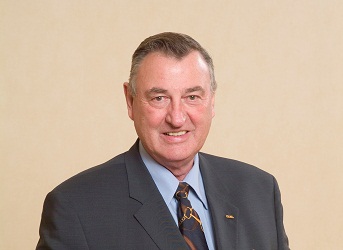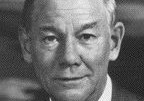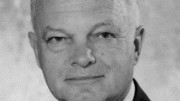The Canadian Mining Hall of Fame will welcome four new inductees at its twenty-fifth annual induction dinner on Jan. 10, 2013, at the Fairmont Royal York Hotel in Toronto. The new inductees are Charles E. Fipke, Gerald W. Grandey, Pierre Lassonde and James C. O’Rourke. The Northern Miner is a sponsor of the Canadian Mining Hall of Fame. For tickets and more information, visit www.mininghalloffame.ca.
Geologists and prospectors had searched for diamond deposits in North America for more than a century with only teasing hints of success until discovering a cluster of kimberlites in the Northwest Territories that became Ekati, Canada’s first diamond mine. This groundbreaking discovery, synonymous with the name “Charles E. (Chuck) Fipke,” was the culmination of Fipke’s relentless pursuit of elusive diamond indicator minerals for hundreds of kilometres from the Mackenzie River Valley eastward to their source near Lac de Gras. Other key contributors in his quest were his associate, geologist Stewart Blusson, economic geologist Hugo Dummett and University of Cape Town professor John Gurney. The discovery’s epic success — achieved on a shoestring budget through innovative science — sparked a staking rush, inspired other discoveries and created a new industry for Canada.
Born in Edmonton, Alta., Fipke earned a B.Sc. degree in geology from the University of British Columbia (UBC) in 1970. His adventurous nature took him to Papua New Guinea, South Africa, Brazil and other exotic locales, where he worked for senior companies such as Kennecott and Cominco, and became intrigued with the use of heavy mineral geochemistry as an exploration tool.
Fipke opened Kelowna-based CF Mineral Research to specialize in heavy mineral processing and analysis in 1977, and later managed a diamond exploration program for Superior Oil that led to Canada’s North. After Superior withdrew from the venture in 1982, Fipke and Blusson continued the search, forming Dia Met Minerals in 1984. They were among the few Canadian geologists to understand the significance of indicator minerals associated with diamond-bearing kimberlites, and how they could be traced back to their source. This was no easy task in the North, where mineral trains were transported great distances by glacial activity.
Fipke persevered and found evidence of diamond-bearing kimberlites near Lac de Gras. His success led Dia Met to a business deal with Dummett’s employer, BHP Minerals, in 1990, with the partners reporting their first diamond discovery in 1991. This event sparked a staking rush that led to several other discoveries in the region.
Ekati mine’s official opening in 1998 was a transformative event that established Canada as the third largest producer by value of high-quality diamonds, and laid the foundation for a progressive new industry employing thousands of Aboriginal Peoples and northerners.
Fipke also contributed to the industry’s growth by publishing the first guide to diamond exploration using indicator mineral geochemistry. He remains active in mineral exploration, among other endeavors. In 2006, he established the Charles Fipke Centre for Innovative Research at UBC Okanagan and the WildAid Canada Foundation to protect endangered species in 2009.
In addition to an honorary Doctorate of Technology from Okanagan University College, Fipke has received many awards for his achievements, notably The Northern Miner’s Mining Person of the Year (1992), Prospector of the Year (1992), the H.H. “Spud” Huestis Award (1997), the Daniel C. Jackling Award (2004) and the Robert M. Dreyer Award (2005).
When Gerald Grandey joined Cameco in 1993, his mandate as senior vice-president of marketing and corporate development was to help the company grow beyond its core Rabbit Lake and Key Lake uranium mines in Saskatchewan. He rose to that challenge, and many others, after becoming president and CEO in the early 2000s. When he retired in 2011, Cameco accounted for 16% of the world’s uranium output with five mines in Canada, the U.S. and Kazakhstan, and was an integrated nuclear energy company. But Grandey did more than expand production, and increase market capitalization by 350% to $9.6 billion from $2.1 billion: he helped Cameco become Canada’s largest industrial employer of Aboriginal people and a world leader in nuclear safety, played a pivotal role in a global nuclear disarmament agreement and raised the profile of nuclear power as clean energy.
Grandey ironically began his law career in the 1970s by opposing nuclear-plant licensing in the Great Lakes region of his native U.S., later some of Cameco’s best customers. His views changed as he learned about the industry and its potential benefits for the world. He understood the underlying science and technology, having earned a degree in geophysical engineering from the Colorado School of Mines in 1968. In 1978, Grandey joined Denver-based Energy Fuels, and helped transform it from a small uranium producer into the largest U.S. producer.
When Bernard Michel recruited Grandey as a critical member of his team in the 1990s, Cameco was developing the challenging Kumtor gold project in Kyrgyzstan. Led by Grandey, newly listed Centerra Gold raised $871 million in 2004 to operate Kumtor and hold other gold assets, enabling Cameco to focus on its core business.
Grandey ably faced water inflow and other technical challenges at McArthur River and Cigar Lake, the world’s largest and highest grade uranium mine and largest undeveloped high-grade uranium deposit, respectively, both in Saskatchewan’s Athabasca basin. He took steps to incorporate lessons learned and instill a corporate culture based on safety first, risk awareness, operational excellence and clear accountability.
Grandey played a leadership role in negotiating the Highly Enriched Uranium agreement, aimed at dismantling Russian nuclear weapons and securely transferring the displaced uranium for electricity at Western nuclear power plants. This complex multi-party agreement was a transformative political achievement that elevated the credibility of Cameco and Canada on the world stage. It was also a commercial success implemented without market disruption.
In 2011, Grandey was appointed Chairman Emeritus of the World Nuclear Association in recognition of his career achievements and contribution to the peaceful use of nuclear energy. Among other awards, he received Saskatchewan’s Centennial Medal in 2005, a tribute to his community involvement, advocacy of corporate social responsibility and impressive track record of providing employment and business opportunities for Aboriginal Peoples of the province.
Pierre Lassonde has long believed that a nation’s natural resources are not its commodities, but its people. He proved this during his own exemplary career as a professional engineer, astute investor, innovative financier, entrepreneurial company builder, dedicated philanthropist and senior statesman of Canada’s mining and investment industries. He also invested in human resources through generous contributions to universities that produce enduring and incalculable returns, including a new generation of industry professionals.
Born in Saint-Hyacinthe, Que., Lassonde earned a degree in electrical engineering in Montreal, followed by an M.B.A. from the University of Utah in 1973. After a stint with Bechtel in San Francisco, he joined Beutel Goodman & Company and managed its gold investment fund for more than a decade. He launched Franco-Nevada Mining in 1982, after teaming up with Seymour Schulich. Their goal was to create a cash-generating royalty company based on the model used in the oil and gas industry, but focused instead on gold, which to their surprise hadn’t been attempted before. In 1986, they paid $2 million to acquire royalties in a small heap-leach mine in Nevada, later developed into t
he world-class Goldstrike mine by Barrick Gold. Production from Goldstrike and other royalty properties grew to over 3 million oz. annually, and the strength of the new business model could be seen in the exceptional 36% annualized rate of return it provided shareholders over a 20-year period.
The new royalty business model was extended to exploration properties with Euro-Nevada and base metals with Redstone Resources. As the mining industry slowed down in the late 1990s, all three companies were merged into Franco-Nevada. In 2002, at the bottom of the gold cycle, Franco spearheaded a three-way merger between Normandy Mining of Australia and Newmont Mining of Denver to create the world’s largest gold mining company at the time. In 2008, Lassonde, along with David Harquail and the Franco-Nevada team who had followed him at Newmont, acquired Newmont’s royalty portfolio and revived Franco-Nevada as the largest gold royalty company on the Toronto Stock Exchange. The $1.2-billion initial public offering was, at the time, the largest mining IPO ever offered on the TSE.
As a philanthropist, Lassonde has made generous donations to many educational institutions, including York University and the University of Utah. He established the Lassonde Chair in Mining Engineering at the University of Toronto in 1996, followed by the Lassonde Mineral Engineering program and the Lassonde Institute for Engineering Geosciences in 2000. He is author of the acclaimed investors’ guide The Gold Book, first published in 1990. He is also a renowned gold-mining expert, and served as chairman of the World Gold Council from 2005 to 2009. A passionate supporter of Canadian art, Lassonde served as chairman of the Musée National des Beaux-Arts du Québec, and has a large personal collection of work by Canadian artists.
Lassonde has received many awards, including The Northern Miner’s Mining Person of the Year (1997) and Developer of the Year (1999) with Seymour Schulich, the Inco Medal (2001), several honorary doctorates in Canada and the U.S. and the Order of Canada in 2003.
James O’Rourke began his career as a mining engineer working on a new generation of mines being developed by visionary industry leaders during the expansionary post-war decades. This experience set the stage for a career as a mine-maker, company builder and advocate of progressive industry partnerships. He exemplifies the optimistic spirit of his native B.C., where he played leadership roles in developing the Quinsam coal mine, the Cassiar asbestos mine, the Huckleberry copper mine and the Similco copper mine, later revived and expanded as Copper Mountain, among other endeavours. In addition to building companies such as Princeton Mining and Copper Mountain Mining, he forged strong partnerships with Pacific Rim trading partners, setting a precedent for other companies and industries to follow as part of the Pacific Gateway initiative.
Born in Prince George, O’Rourke earned a B.Sc. in mine engineering from UBC in 1964 before joining Placer Development, then under the leadership of the legendary John Simpson. Over the next 14 years, he was involved in the start-up of five mines, beginning his mining career at Craigmont — the first large, integrated open-pit mine in Western Canada, and the first to introduce sub-level caving — and moving directly to the start-up of Endako molybdenum mine, followed by the challenging Marcopper mine built on a remote island in the Philippines. Returning to B.C. in the early 1970s, he was involved with starting up the Gibraltar open-pit copper mine. He then joined Brinco and led development of the Quinsam coal mine on Vancouver Island, before ushering in a new career phase as president of Princeton Mining.
O’Rourke turned his attention to past-producing mines, including Cassiar, which he revived for several years with the transition from an open pit to a block-cave underground mine. In 1988, he acquired the historic Similco open-pit copper mine near Princeton, which operated until 1996. O’Rourke spearheaded the Huckleberry copper project near Houston, which he advanced through the feasibility and construction stages to production. Mitsubishi Mining Corp. and three other Japanese companies invested in the $140-million open-pit copper mine, which began operations in 1997 with an expected life until 2021.
As metal prices improved — driven by demand from China and other emerging economies — O’Rourke seized the opportunity to reacquire Similco in late 2006. He formed Copper Mountain Mining and assembled an experienced team, including former associates, to revive the project as Copper Mountain. Mitsubishi again came onboard, this time as a 25% partner, and arranged debt financing.
Copper Mountain was officially reopened as a $438-milllion, 35,000-tonne-per-day mine in August 2011. It employs 360 people and has a projected life of 17 years.
In addition to building mines and companies, O’Rourke has built strong relationships with First Nations and contributed to community initiatives near his mining projects. He is a founder of the “Mining for Miracles” campaign, which has raised more than $20 million for the B.C. Children’s Hospital since 1988. He is a 2011 recipient of the Order of British Columbia, and has won many awards over the years, including the prestigious Edgar A. Scholz Medal for excellence in mine development in 2005.






Be the first to comment on "Four greats to enter Canadian Mining Hall of Fame"